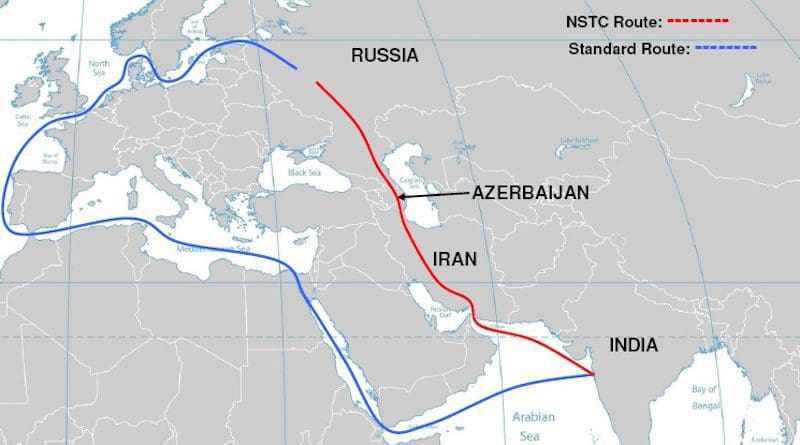Geopolitical Dynamics And Economic Prospects Of International North-South Transport Corridor (INSTC) For Bangladesh – Analysis
The International North-South Transport Corridor (INSTC) has emerged as a critical multi-modal transport project, spanning over 7,200 kilometers, with the ambitious goal of facilitating seamless cargo transportation among Afghanistan, Armenia, Azerbaijan, Russia, Central Asia, Europe, India, and Iran.
Although established in 2000 and ratified in 2002 by India, Iran, and Russia, the full potential of INSTC remained obstructed by the stranglehold of sanctions on Iran. However, as geopolitical dynamics shifted, the easing of sanctions and India’s renewed interest in the project propelled INSTC into action. The corridor’s route, from Mumbai to Russia via Iran, offers a promising alternative for global trade, and Bangladesh, with its burgeoning economy, strategic location, and strong diplomatic ties with India, stands at the threshold of untapped opportunities within this transformative initiative.
The geopolitical landscape underwent a seismic shift when the United States withdrew from the Joint Comprehensive Plan of Action (JCPOA) in 2018, imposing stringent sanctions on Iran. This abrupt change created a ripple effect, impacting India’s infrastructure projects, causing impediments such as reduced investment, bureaucratic delays, and inter-regional disputes. Despite these challenges, India’s strategic foresight led to investments in the Chabahar Port in Iran’s Sistan-Balochistan province, aligning with its pursuit of alternative routes to connect with resource-rich Central Asia. Simultaneously, India signed an intergovernmental agreement for the INSTC, demonstrating a commitment to diversify its transportation networks and boost regional connectivity.
By 2018, following the easing of sanctions, the INSTC gained momentum, witnessing the transportation of approximately 11 million tonnes of goods through its corridors. In July 2022, the first shipment using the INSTC arrived at Jawaharlal Nehru Port in Mumbai, originating from Russia’s Astrakhan Port. The corridor’s sea routes, rail links, and road connections provide a comprehensive network connecting Mumbai to Saint Petersburg, passing through the strategically located Chabahar. The projected reduction in transit time by 40%, from 45-60 days to 25-30 days, coupled with an anticipated 30% decrease in freight costs compared to the Suez Canal route, underscores the transformative potential of the INSTC.
In the broader South Asian context, Bangladesh emerges as a rising economic star, often hailed as the latest economic miracle in the region. Boasting a booming economy, the country’s renowned garments sector stands as one of the world’s largest, albeit with a significant dependence on imported cotton and other materials. As Bangladesh positions itself on the global economic stage, the INSTC presents a compelling avenue for the nation to harness its economic prowess and expand its global trade footprint.
Given the proximity and solid diplomatic relations between Bangladesh and India, the former is strategically positioned to leverage INSTC connectivity. The existing links between Indian and Bangladeshi ports, particularly through the Mumbai–Chennai and Chabahar ports, offer a direct pathway for Bangladesh to integrate with the INSTC. Notably, the Chittagong and Mongla ports, pivotal components of Bangladesh’s maritime infrastructure, can seamlessly connect with the INSTC, unlocking a plethora of trade and export opportunities.
Connectivity, both regional and global, is an indispensable element for any nation aspiring to thrive in the contemporary economic landscape. Bangladesh, recognizing the imperative of robust connectivity, can strategically position itself as an active participant in the INSTC. This involvement extends beyond mere economic considerations; it aligns with Bangladesh’s broader vision of becoming a key player in shaping regional and global trade dynamics.
The collaborative potential between Bangladesh and the INSTC is not confined to geographical proximity alone. Bangladesh’s strategic collaboration within the corridor can extend to exploring investment opportunities in sectors such as infrastructure, energy, and technology. As a major player in the region, Bangladesh has much to offer in terms of manpower, skilled labor, and a burgeoning consumer market. Conversely, the INSTC can serve as a gateway for Bangladesh to diversify its economic portfolio by importing essential commodities like cotton from Central Asian states and wheat from Russia.
Bangladesh’s export potential within the INSTC framework is vast and multifaceted. The country, renowned for its garments sector, can tap into the demand for textiles in Central Asian states, Russia, and China. Simultaneously, Bangladesh can position itself as a reliable exporter of leather, apparel, and agricultural products, including potatoes, to these regions. The INSTC, with its streamlined transport routes, provides a conduit for Bangladesh to not only expand its export markets but also forge economic synergies with diverse economies along the corridor.
The utilization of the Chabahar Port holds particular significance for Bangladesh’s integration into the INSTC. As a key maritime facility in Iran, the Chabahar Port not only offers a direct link for Bangladesh to connect with the corridor but also serves as a gateway for increased exports to Iran and to a broader extent to the Middle East. Bangladesh’s access to the Chabahar Port provides a strategic advantage, enabling efficient trade routes and fostering economic ties with Iran, a country that has historically been a significant player in the region.
Bangladesh stands at a critical juncture where strategic decisions regarding its participation in the International North-South Transport Corridor can significantly shape its economic trajectory. The INSTC, with its transformative potential in reducing transit times and freight costs, offers Bangladesh a gateway to diversify its trade, attract investments, and strengthen diplomatic ties with key regional players. As Bangladesh continues its ascent as an economic powerhouse in South Asia, active engagement with the INSTC aligns with the nation’s broader vision of becoming a key player in shaping the future of regional and global trade. The imperative lies in seizing the untapped opportunities within the INSTC and strategically positioning Bangladesh as a vital participant in this transformative initiative.

